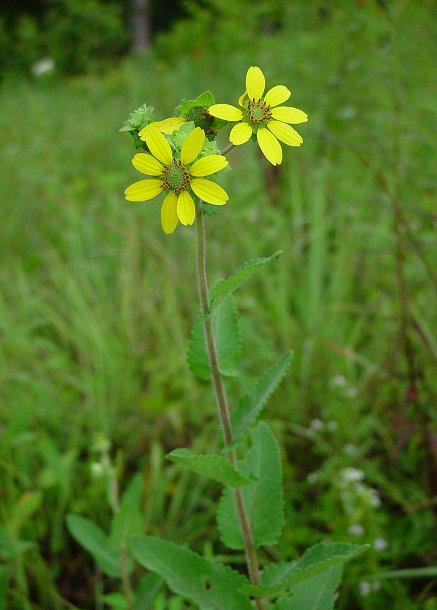Berlandiera texana DC.
Texas Green Eyes

Native
CC = 5
CW = 5
MOC = 18
© DETenaglia
Berlandiera texana DC.Texas Green Eyes | |
 |
Native CC = 5 CW = 5 MOC = 18 |
© DETenaglia |
|
Family - Asteraceae/Heliantheae Habit - Perennial forb with fleshy taproot, sometimes woody at base. Stems - Ascending to erect, to 1.2 m, multiple from the base, herbaceous, branching near the apex, densely pubescent with soft, tangled, multicellular hairs.
Leaves - Alternate, sessile, or the lowest short-petiolate, simple. Petioles to 10 mm long, pubescent. Blades cordate, scalloped, ovate, pubescent on both surfaces, to 15 cm long, 10 cm broad, bluntly or sharply pointed at the apex, bases often clasping stem, reduced upward.
Inflorescence - Solitary heads or small clusters at the branch tips, sometimes appearing as open, flat-topped panicles, the heads with short to relatively long, bractless, densely hairy stalks. Heads radiate. Involucre - Involucre 6-10 mm long, 9-15 mm in diameter, mostly broadly cup-shaped, the bracts in 2 or 3 somewhat unequal, overlapping series. Involucral bracts 14-22, loosely ascending or the tip somewhat reflexed or spreading, green with entire, hairy margins, the surfaces densely hairy and with minute, orange glands, with 5-11 fine nerves (these sometimes obscured by the hairs).
Heads - Receptacle shallowly convex, usually with a flat or slightly concave central portion, with chaffy bracts subtending the disc florets, these 4-5 mm long, linear to narrowly oblong, hairy, especially along the margins, relatively flat. Ray florets 5-11, pistillate, the corolla 10-20 mm long, relatively broad, yellow to orangish yellow, often notched at the apex, the tube densely hairy and glandular, the ligule with the undersurface sparsely to moderately hairy, glandular, and with green veins, not persistent at fruiting. Disc florets numerous, staminate (the nonfunctional ovary slender and hairy), the corolla 3-4 mm long, deep reddish, sparsely glandular and with the lobes usually densely short-hairy on the upper surface, not expanded at the base, not persistent at fruiting. Style branches with the sterile tip very short and more or less truncate. Pappus of the ray and disc florets absent or occasionally of a few minute, papery teeth.
Fruits - Achenes 4.5-6.0 mm long, obovate to broadly oblong-obovate, strongly flattened, black at maturity, the inner surface densely hairy but difficult to observe because obscured by the basally fused sterile ovaries of the adjacent disc florets and chaffy bracts, the outer surface fused with the adjacent involucral bract (this tan to brown at fruiting), the whole assemblage dispersed as an intact unit.
Flowering - June - October. Habitat - Upland prairies, glades, bluffs, openings in upland forests. Origin - Native to U.S. Lookalikes - Flowering heads are similar to many others in the Asteraceae, but unique in detail. Leaves are characteristic. Other info. - This species can be found in the southern Ozark region of Missouri. Elsewhere it occurs in the south-central states of the continental U.S. It is a characteristic plant of glades and rocky woods. B. texana is a very showy plant and deserving of more widespread cultivation. It is easily identified in the field by its densely pubescent stems, clasping leaves, and habitat. Photographs taken at the Peck Ranch Wildlife Refuge, Carter County, MO., 7-12-03 (DETenaglia); also at Shaw Nature Reserve, Franklin County, MO, 9-10-2017 (SRTurner). |